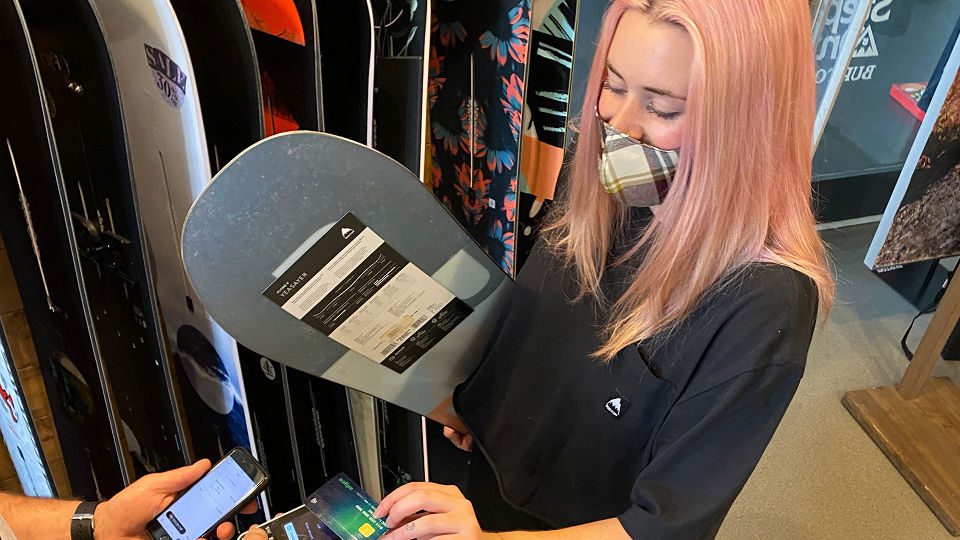While the name Burton is almost synonymous with the snowboards the company began making in 1977, Burton has diversified over the years into new categories — including surfboards, apparel, goggles/optics and other sports gear — as well as expanding beyond manufacturing into direct-to-consumer (DTC) retail, both physical and digital.
The Burton name is on 66 stores in 10 countries and the principality of Andorra, as well as the U.S. The company owns and operates 34 locations, both flagships or outlets, and the remainder are owned and operated by partners such as high-end resorts.
Ready to grow even further, the company launched a digital transformation to swap out its legacy systems, advance customer knowledge through data and provide a truly omnichannel customer experience. With a new retail management solution in place, Burton will now be able to:
- Deploy mobile POS (mPOS) devices in its stores;
- Provide store associates with improved visibility into customer, product and inventory data; and
- Gain a unified view of its e-Commerce and brick-and-mortar operations at both the store and headquarters levels.
Digital Transformation Required Building Trust In Burton’s Data
Burton’s business has changed over the years, from almost exclusively wholesale to a 75%/25% mix of wholesale and DTC, but its systems hadn’t changed with it, explained Josee Larocque, Burton’s SVP of DTC and Digital Transformation in an interview with Retail TouchPoints.
The executive team sees the less developed DTC side as a bigger growth opportunity at this stage of the company’s lifecycle, but “wholesale is a great business and we have no intention of moving away from it,” she noted.
Larocque has spent more than 20 years with Burton, becoming SVP Operations in 2010. Although she had taken on more responsibilities, including oversight of the burgeoning DTC business, IT and web development, her title hadn’t changed. “Our founder and chairman of the board said, ‘You need a new title.’ I said, ‘Let’s call it direct to consumer and digital transformation.’ That’s my job at Burton nowadays,” she recalled.
She took a three-pronged approach to digital transformation. “The first prong is data modernization, because every system and everything in the digital world relies on data governance, data management and data trustworthiness,” she said. “We began the journey by getting our heads around the data.”
The second prong was replacing foundational systems, such as the company’s legacy enterprise resource planning (ERP) system. “It was coming close to its end-of-life, and we didn’t want to come up against that deadline,” she said. An important factor in the decision was to be able to support and grow Burton’s retail business.
Store Associates Gain Access To Up-To-Date Data
The final prong was in Burton’s customer-facing solutions, comprising technologies for e-Commerce, marketing, social media, customer service and a retail POS. Like its ERP system, Burton’s POS was dated and needed to be replaced.
After investigating multiple solutions over a period of months, Burton selected the NewStore Omnichannel Platform, which provides mobile POS through iPhone apps and gives personnel on the retail floor visibility into customer, product and inventory data. The platform connects into Salesforce Commerce Cloud, providing a unified view of e-Commerce and store operations at both the store and headquarters level.
“We started the program with NewStore in earnest in January 2020 and started rolling the system out to stores in the beginning of June,” Larocque said.
The NewStore deployment had been scheduled for June prior to the pandemic, so Burton went through with the rollout even though not all of its stores had fully reopened. Depending on local restrictions, some stores were allowed to do phone sales or customer visits by appointment, but “very few of our doors were wide open at that point,” she noted.
Larocque explained that Burton’s legacy ERP system had provided good visibility into much of the supply chain, from the purchase order stage through transit and up to the distribution center. “Where we didn’t have great visibility was between what was in our physical stores versus what was in our distribution center. Those inventories and orders were not in one system,” she said.
Although the two systems would sync up every few hours, there was a chance that Burton Guides — the company’s title for its associates — could be giving customers incorrect information. “It was fraught with opportunities to disappoint a customer,” Larocque said.
With NewStore, “the Guides feel confident because they can trust the data in that system and consumers see them as capable,” she added. “We think this tool is empowering and really exciting, not only for the Guides, but also for the customers.”
Greater Emphasis On DTC Provides Deeper Customer Insights
“It’s really a holistic approach,” she said. “We put the customers at the center and really get to know them. We use data to understand what is propelling their journey with Burton. As we do that, we’re going to become a better company and a better brand.”
Burton’s history and status as a snowboarding company is a valuable asset, but one of the company’s objectives is to use customer data to drive sales in areas where Burton is less well known. “People know us for snowboarding. They know us for winter, but we make great, versatile products that are good year-round,” she said.
“If a customer walks into a store and says, ‘My hands are full, ship it to me,’ that’s one experience we have to offer. If they want to shop online at home and get it quickly, they don’t care if it’s coming from their local brick-and-mortar store or a distribution center,” Larocque said. “And if they want to shop online and pick it up in the store, that’s just another option we have to be able to provide.”
The need for this level of flexibility has become even clearer in recent months, Larocque pointed out. “We certainly didn’t think buy online for curbside pickup was going to be so important so quickly, but the pandemic certainly accelerated that trend,” she said.
“When you have a good clean order management system, a good clean inventory management system, good data at the front end and a good ERP at the back-end, I think you’re set up for anything that could be thrown at you,” she said. “That’s why we feel we’re in a really great position right now. We’ve got the right tools to meet customer and market needs, whatever they may be.”













